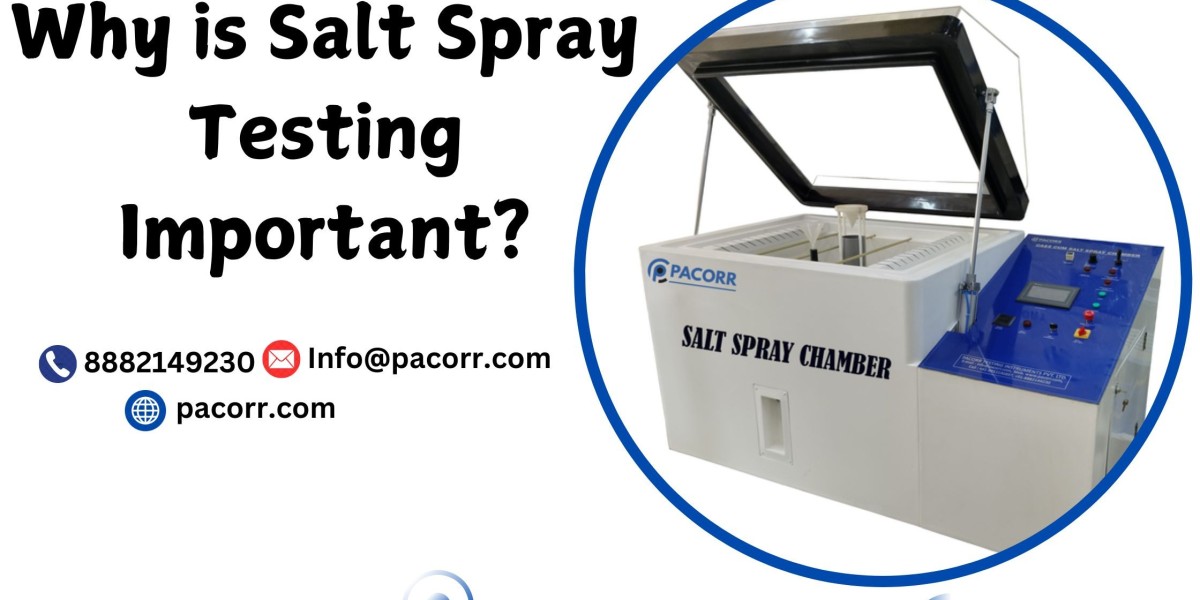One of the most effective ways to predict the longevity of materials and coatings in aggressive environments is through salt spray testing. The Salt Spray Chamber from Pacorr Testing Instruments Pvt Ltd is a state-of-the-art solution that simulates real-world corrosion conditions, helping businesses ensure that their products can withstand harsh environments.
In this article, we will explore how the Salt Spray Chamber works, its applications, and how it can benefit your business by ensuring the durability and quality of your products.
Understanding the Salt Spray Chamber
A Salt Spray Chamber is a controlled testing environment designed to simulate the corrosive effects of saltwater exposure on materials and coatings. This method is widely used in industries like automotive, aerospace, and manufacturing to test the corrosion resistance of components and materials.
Pacorr's Salt Spray Chamber uses a highly controlled environment to simulate the accelerated effects of corrosion that occur in real-world environments. The chamber generates a mist of saltwater, which settles on the surface of the materials being tested. By controlling factors such as temperature, humidity, and salt concentration, the test chamber mimics the conditions of materials exposed to marine environments, coastal areas, and industrial settings.
How Pacorr's Salt Spray Chamber Works
The Salt Spray Test Chamber works by exposing samples to a fine mist of salt solution in a controlled, heated environment. The chamber's cycle includes a specific temperature, humidity, and spray rate that are maintained throughout the testing process. Here's how it works step by step:
- Sample Preparation: The materials or components to be tested are placed inside the chamber on a specially designed rack or fixture.
- Mist Generation: A salt solution, typically a mixture of water and sodium chloride (NaCl), is atomized into a fine mist using compressed air. This mist is directed at the samples inside the chamber.
- Controlled Environment: The chamber is kept at a controlled temperature and humidity to simulate specific environmental conditions. Temperature settings typically range from 35C to 50C.
- Test Duration: The exposure time can vary depending on the material and the desired outcome. It could range from a few hours to several weeks, depending on the corrosion resistance requirements.
- Evaluation: After the test is complete, the samples are inspected for signs of corrosion, such as rust, pitting, or discoloration. The level of corrosion is then documented and analyzed.
Why Salt Spray Testing Is Crucial
Salt Spray Testing is essential for assessing the performance of materials, coatings, and finishes in environments where they are exposed to corrosive elements like saltwater. By simulating these conditions in a controlled environment, manufacturers can evaluate their products' durability and ensure their longevity in real-world scenarios.
Here are some key reasons why Salt Spray Testing is crucial for your products:
- Predicts Product Longevity: Salt Spray Testing helps manufacturers predict the lifespan of materials and coatings by simulating real-world corrosive environments. This is particularly important for industries like automotive, aerospace, and marine.
- Improves Product Quality: The testing allows manufacturers to identify weak points in materials and coatings, enabling them to make improvements before the products reach the market.
- Ensures Safety and Reliability: For industries like aerospace and automotive, the safety and reliability of components are paramount. Salt Spray Testing ensures that products meet the required standards for corrosion resistance, reducing the risk of failure.
- Meets Industry Standards: Many industries have strict corrosion resistance standards that products must meet. Salt Spray Chamber Price helps manufacturers ensure compliance with these regulations, improving product quality and reducing the likelihood of costly rejections.
Key Features of Pacorr's Salt Spray Chamber
- Advanced Control System: Pacorr's Salt Spray Chamber features an advanced control system that allows precise control over temperature, humidity, and spray rates. This ensures that the testing environment remains consistent and accurate, producing reliable results.
- Wide Range of Temperature Settings: The Salt Spray Chamber can operate within a wide range of temperatures, allowing testing to be tailored to specific needs, from mild coastal conditions to extreme marine environments.
- User-Friendly Interface: The intuitive touch screen interface makes it easy for operators to set up and monitor tests. With real-time data tracking and system diagnostics, users can ensure optimal performance.
- Durable Construction: Built with high-quality materials, the Salt Spray Chamber is designed for durability and longevity, even with continuous operation.
- Compliance with International Standards: Pacorr's Salt Spray Chamber is designed to meet the highest industry standards, including ASTM B117, ISO 9227, and other international testing protocols.
Applications of Salt Spray Testing
Salt Spray Testing is applied across various industries, where corrosion resistance is critical. Here are some common applications:
- Automotive Industry: Components such as body panels, wheels, and engine parts are tested for corrosion resistance to ensure durability and reliability.
- Aerospace Industry: Aircraft parts exposed to high levels of salt and moisture are tested to ensure they meet stringent corrosion resistance requirements.
- Marine Industry: Equipment and materials used in marine environments, including boats, ships, and offshore structures, undergo Salt Spray Testing to ensure they can withstand harsh saltwater exposure.
- Construction Materials: Materials used in construction, such as metal pipes, coatings, and structural steel, are tested to ensure they do not degrade when exposed to environmental conditions.
Conclusion
In todays competitive market, ensuring that your products are durable, reliable, and capable of withstanding environmental challenges is crucial. Pacorr's Salt Spray Chambers provides an efficient and accurate method to test the corrosion resistance of materials and coatings, ensuring that your products meet industry standards and customer expectations.
By incorporating Salt Spray Testing into your product development process, you can reduce the risk of product failures, enhance your product's quality, and gain a competitive edge in the marketplace. If you are looking for reliable and high-quality Salt Spray Testing solutions, Pacorr Testing Instruments Pvt Ltd offers the perfect solution for your needs.
For more information about our Salt Spray Chamber, visit pacorr.com and discover how our advanced testing instruments can help improve the quality of your products.








